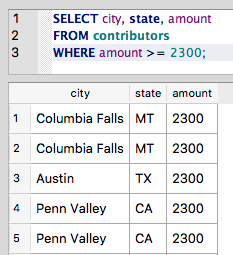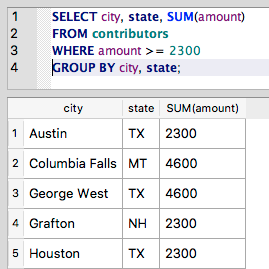HAVING¶
Now that we understand grouping and aggregates, let’s try filtering the results based on an aggregate. To start, let’s find all cities for which contributions total more than $3,000. Here’s a first stab at the query:
SELECT city, state, SUM(amount)
FROM contributors
WHERE SUM(amount) >= 3000
GROUP BY city, state
ORDER BY SUM(amount) DESC;
And … no.

The error message isn’t very helpful, but you can see “misuse of aggregate: SUM()” is mentioned.
Turns out that aggregate functions can’t be used in a WHERE clause. The
WHERE clause acts as a filter on each row in turn, but here we want to
test an expression against an aggregate value for a group of rows (SUM(amount)).
The equivalent of a WHERE clause for aggregates is HAVING.
It appears after the GROUP BY:
SELECT city, state, SUM(amount)
FROM contributors
GROUP BY city, state
HAVING SUM(amount) >= 3000
ORDER BY SUM(amount) DESC;

To get a better sense of the difference between WHERE and HAVING, let’s
first look at a fairly simple query using WHERE:
SELECT city, state, amount
FROM contributors
WHERE amount >= 2300;
This query looks for individual contributors who have given at least $2,300, and it returns their city, state and amount.

Now let’s make this into an aggregate query by adding a GROUP BY and an
aggregate function:
SELECT city, state, SUM(amount)
FROM contributors
WHERE amount >= 2300
GROUP BY city, state;

We have the same nine cities that we had in the first query (those
cities in which someone donated at least $2,300). But now, rather than
having one row per contributor, we have one row per city. The GROUP BY
eliminates the duplicate entries for cities in which more than one
person contributed at least $2,300. And by using the aggregate function
for SUM (amount), we’re adding up all contributions of at least $2,300
for each city.
Now let’s further filter this list of cities. We want to look only at cities in which these large contributions ($2,300 or greater) made a big difference. Let’s call $4000 a big difference, for the sake of argument. So, we want only those cities for which the total amount of contributions at this size exceeds $4000.
Looking at the results from the last query, we know to expect 3 rows, but it’s not always so easy to see.
Here goes:
SELECT city, state, SUM(amount)
FROM contributors
WHERE amount >= 2300
GROUP BY city, state
HAVING SUM(amount) > 4000;
And bam! We now have a list of cities where large contributions totaled more than $4000.
